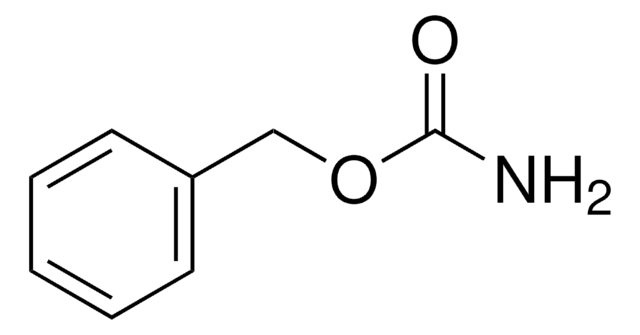10906
Chloroacetaldehyde dimethyl acetal
Wacker Chemie AG, ≥99.0% (GC)
Synonym(s):
CADMA, 2-Chloro-1,1-dimethoxyethane, Dimethyl chloroacetal
Sign Into View Organizational & Contract Pricing
All Photos(1)
About This Item
Linear Formula:
ClCH2CH(OCH3)2
CAS Number:
Molecular Weight:
124.57
Beilstein:
1733700
EC Number:
MDL number:
UNSPSC Code:
12352100
PubChem Substance ID:
NACRES:
NA.22
Recommended Products
Assay
≥99.0% (GC)
manufacturer/tradename
Wacker Chemie AG
refractive index
n20/D 1.415 (lit.)
bp
128-130 °C (lit.)
density
1.094 g/mL at 25 °C (lit.)
SMILES string
COC(CCl)OC
InChI
1S/C4H9ClO2/c1-6-4(3-5)7-2/h4H,3H2,1-2H3
InChI key
CRZJPEIBPQWDGJ-UHFFFAOYSA-N
Looking for similar products? Visit Product Comparison Guide
Related Categories
General description
Chloroacetaldehyde dimethyl acetal is a clear, colorless liquid. It reacts with hydroxythiol to form hydroxy acetal.
Application
Chloroacetaldehyde dimethyl acetal can be used as a reactant to synthesize:
- 2-(chloromethyl)-4,7-dethyl-1,3-dioxepane
- 2-(chloromethyl)-5,6-benzo-1,3-dioxepane
- ketene dimethyl acetal
Chloroacetaldehyde dimethyl acetal was used to investigate the enzymes used for activation and transformation of vinyl chloride. It was also used for introducing O-(2,2-dimethoxyethyl) groups into amylose, dextran, and a linear (1→3)-β-D-glucan. Chloroacetaldehyde dimethyl acetal was utilised in the synthesis of ethoxyacetylide.
Other Notes
prices for bulk quantities on request
Signal Word
Warning
Hazard Statements
Precautionary Statements
Hazard Classifications
Acute Tox. 4 Oral - Aquatic Chronic 3 - Flam. Liq. 3
Storage Class Code
3 - Flammable liquids
WGK
WGK 2
Flash Point(F)
84.2 °F - closed cup
Flash Point(C)
29 °C - closed cup
Personal Protective Equipment
dust mask type N95 (US), Eyeshields, Gloves
Choose from one of the most recent versions:
Already Own This Product?
Find documentation for the products that you have recently purchased in the Document Library.
Coupling of polysaccharides activated by means of chloroacetaldehyde dimethyl acetal to amines or proteins by reductive amination.
B?gwald J, et al.
Carbohydrate Research, 148(1), 101-107 (1986)
Free radical ring-opening polymerization of 4, 7-dimethyl-2-methylene-1, 3-dioxepane and 5, 6-benzo-2-methylene-1, 3-dioxepane.
Bailey WJ
Macromolecules, 15(3), 711-714 (1982)
Activation of vinyl chloride to covalently bound metabolites: roles of 2-chloroethylene oxide and 2-chloroacetaldehyde.
F P Guengerich et al.
Biochemistry, 18(23), 5177-5182 (1979-11-13)
Simple enols. 3. Stereochemistry of simple enols in solution.
Capon B
The Journal of Organic Chemistry, 49(2), 255-257 (1984)
Camphor derived 1, 4-oxathianes for carbonyl epoxidation.
Tetrahedron Asymmetry, 9(10), 1801-1807 (1998)
Our team of scientists has experience in all areas of research including Life Science, Material Science, Chemical Synthesis, Chromatography, Analytical and many others.
Contact Technical Service










